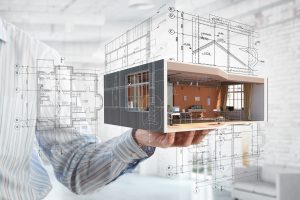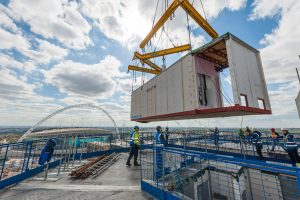Technology is having a profound impact on the construction industry as it embraces innovative and disruptive technologies that were once thought to be science-fiction. Here we take a look at the trends shaping the industry and how companies are staying on top by adopting the latest cutting-edge techniques
1. Virtual Reality
Virtual reality was initially created as an instrument to make video games more immersive but, as the technology has developed, it’s branched into several other sectors, namely that of the construction industry.

VR is changing the way clients interact with a project, making it easier to collaborate and communicate on all stages of a development. It can also be used to put trainee construction workers in realistic situations. VR allows the review process to become far more streamlined, avoiding the issues related to traditional blueprint methods which can become time-consuming.
2. Augmented Reality
Augmented reality is a live, duplicated view of a physical, real-world environment whose elements are augmented (or supplemented) by a computer-generated sensory input. Virtual reality replaces the real world with a simulated one, while augmented reality takes the real world and adds to it with — in the case of architecture — a 3D model of your design.
AR in construction and architecture projects involves placing a 3D model of a proposed design onto an existing space using mobile devices and 3D models.
3. Modular construction
Whilst modular construction may not be entirely new to the industry, it is certainly experiencing a rise in popularity and gaining lots of media attention. This could be down to the fact that modular construction offers an affordable, sustainable and efficient construction solution.
So, what is it? Modular buildings and modular homes are prefabricated buildings, or houses, that consist of multiple sections called modules. A modular building is created offsite and transported to site once complete.
Having already seen an impressive rise in popularity within the construction industry, it’s fair to say modular construction has the potential to make a positive impact on the UK’s on-going housing shortage in a timely and cost-effective way.
4. 3D and 4D modelling
Today, building companies that wholly use 2D representations are relying on outdated methods. It’s likely that 3D modelling is the BIM we are most familiar with – 3D models from BIM look like the world around us. They’re transferrable. With data embedded in the model, they add a dimension present in the world that can’t be achieved in 2D.

However, 4D modelling is an upcoming term within the construction sector. In this context, 4D modelling refers to the fourth dimension of time. In simpler terms, 4D is a 3D model that includes the construction schedule.
4D adds a time dimension to a 3D CAD model, enabling teams to examine the structure of events on a timeline, to envisage the time it takes to complete tasks within the construction process.
5. Offsite
Offsite techniques have been around for a while, but its ever-expanding adoption throughout the industry is creating much debate around its possibility of addressing some the housing shortage issues.
The benefits of offsite techniques are clear, from reduced cost and time, to improved quality and health and safety standards. However, the difficulty at present is that there is no independent industry standard for assessing the benefits of offsite techniques against traditional construction practices.
Perhaps in order to deliver enough homes for all, we need to fully embrace offsite methods!
6. Drones/UAVs
Drones are rapidly replacing traditional land-surveillance methods and in turn changing the way the construction industry works. Drones offer several benefits on building sites: they allow builders an edge on their competition, help save time for land developers during site surveys, and assist the process of meeting safety standards. Not only can drones offer these advantages, but they are also now more affordable than ever!
Drones can also work exclusively with 3D modelling, reducing the amount of time taken to design, analyse and maintain a structure or implement changes.
Whilst the potential for drones is vast, there are still some factors making people cautious about their imminent adoption. Despite this, drones are expected to be a major disruptor within the sector and it is thought that early implementation of the technology will give forward-thinking companies a significant edge in a very competitive market.
7. Green/Sustainable construction
Sustainable construction encompasses almost all levels of construction, from the design of buildings to the materials and technologies utilised, right down to the energy and resource efficiency of a building.

An organisation that can truly consider all of these factors during construction and throughout a buildings entire life cycle not only becomes recognised as considerate and forward-thinking but can also help benefit social and environmental challenges.
The UK’s zero carbon pledge by 2020 has meant sustainable homes are growing in popularity. That being said, it’s pretty obvious why so many more companies are considering and adopting a sustainable approach.
8. 3D printing
3D printing can play a massive role in reducing construction waste. It also increases efficiencies during the building process and allows materials to be reused at the end of the building’s life, rather than ending up as landfill.

Engineers at Arup CLS Architects created a concrete 3D printed house, the first of its kind within the EU, which can be taken apart and reassembled elsewhere. A robot from Cybe Construction was used to print the walls, while the roof, windows and doors were completed afterwards. A team from US architect WATG Urban also showcased the reach of this technology when they created a design for the world’s first freeform 3D printed family home.
9. BIM
BIM is the process of creating and managing information digitally across a construction projects life-cycle. It is the digital description of absolutely every aspect of the built asset. BIM can offer so many advantages from smoother collaboration to a constant supply chain of information that can help assess the risks and vulnerabilities of a project.
Despite the abundance of benefits BIM can bring to a project, its uptake is still somewhat stagnant with many in the industry failing to fully understand and appreciate its full range. Many critics have championed the need for a more collaborative construction industry and hailed BIM as the way forward.
10. Graphene
Graphene has a number of desirable elements that when combined help it become a ‘material of the future’. It’s the strongest, thinnest, lightest, conductive material ever discovered and it’s set to transform the world in which we live. But how is graphene making moves in construction? 
The potential applications of Graphene are heavily varied, though early research has suggested most rewards will be reaped within the electronics industry. From protective paints to spray-on-solar panels, self-cleaning concrete and more durable steel, the applications appear to be endless.
Only time will tell with Graphene, but we expect the future is extremely bright for this wonder material!
11. Blockchain
A blockchain is a continuously growing list of records, called blocks, which are linked and secured using cryptography. The discussion about the potential effect of the Blockchain on the construction industry is becoming more intense as time goes by. In some ways, it could greatly help construction and add more transparency throughout the supply chain.
Blockchain could assist the resolution of construction disputes with the use of smart contracts, it could also significantly optimise the BIM workflow and promote collaboration, we also mustn’t forget the advantage of Bitcoin, which could again boost collaboration and transparency.
But the question remains as to whether the construction industry is ready for the Blockchain… It’s no secret that the construction industry is somewhat hesitant when it comes to change.
There’s clearly a lot to watch out for and look forward to in the construction industry. From robotics to sustainable construction there is enormous capacity for progression.
Keep an eye on this list as we’ll keep updating it with the most upcoming and innovative trends captivating the construction industry!



















